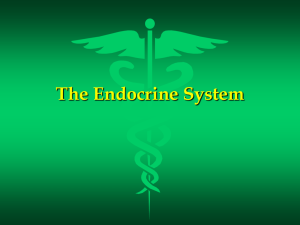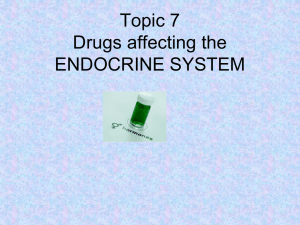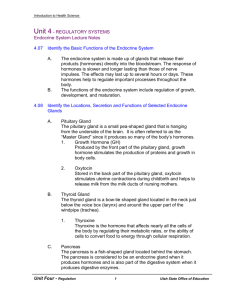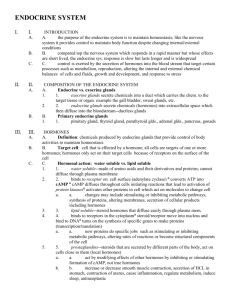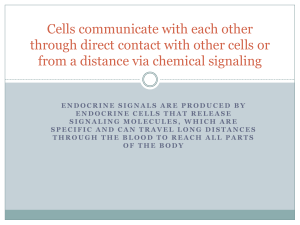Chapter 23: Endocrine Emergencies
advertisement
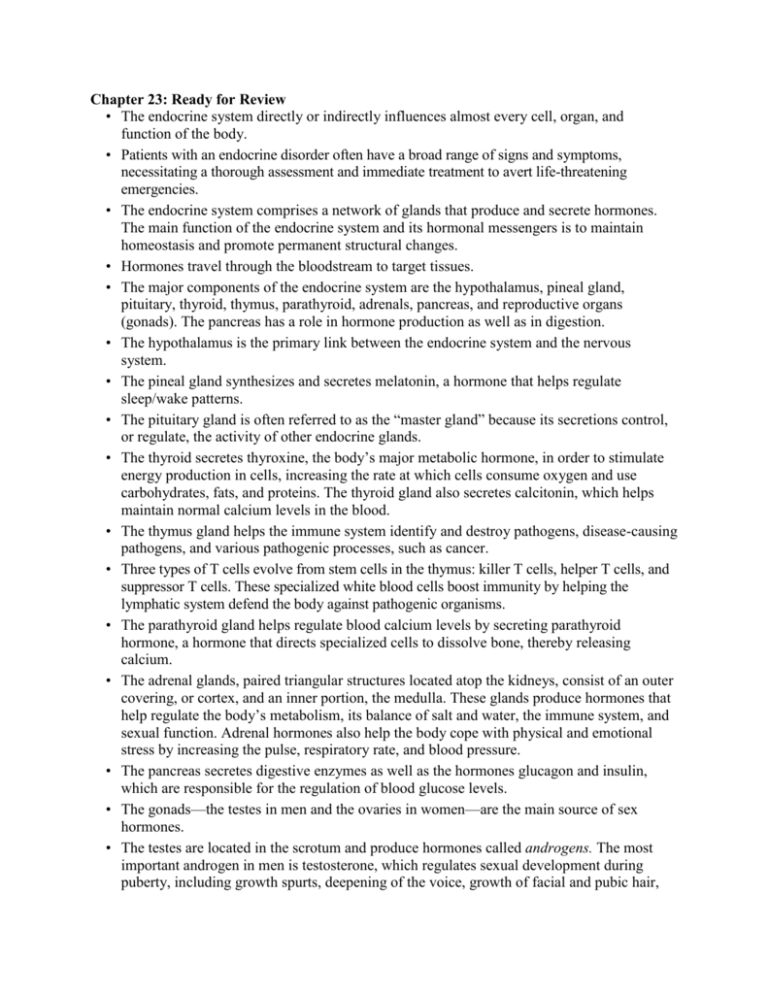
Chapter 23: Ready for Review • The endocrine system directly or indirectly influences almost every cell, organ, and function of the body. • Patients with an endocrine disorder often have a broad range of signs and symptoms, necessitating a thorough assessment and immediate treatment to avert life-threatening emergencies. • The endocrine system comprises a network of glands that produce and secrete hormones. The main function of the endocrine system and its hormonal messengers is to maintain homeostasis and promote permanent structural changes. • Hormones travel through the bloodstream to target tissues. • The major components of the endocrine system are the hypothalamus, pineal gland, pituitary, thyroid, thymus, parathyroid, adrenals, pancreas, and reproductive organs (gonads). The pancreas has a role in hormone production as well as in digestion. • The hypothalamus is the primary link between the endocrine system and the nervous system. • The pineal gland synthesizes and secretes melatonin, a hormone that helps regulate sleep/wake patterns. • The pituitary gland is often referred to as the “master gland” because its secretions control, or regulate, the activity of other endocrine glands. • The thyroid secretes thyroxine, the body’s major metabolic hormone, in order to stimulate energy production in cells, increasing the rate at which cells consume oxygen and use carbohydrates, fats, and proteins. The thyroid gland also secretes calcitonin, which helps maintain normal calcium levels in the blood. • The thymus gland helps the immune system identify and destroy pathogens, disease-causing pathogens, and various pathogenic processes, such as cancer. • Three types of T cells evolve from stem cells in the thymus: killer T cells, helper T cells, and suppressor T cells. These specialized white blood cells boost immunity by helping the lymphatic system defend the body against pathogenic organisms. • The parathyroid gland helps regulate blood calcium levels by secreting parathyroid hormone, a hormone that directs specialized cells to dissolve bone, thereby releasing calcium. • The adrenal glands, paired triangular structures located atop the kidneys, consist of an outer covering, or cortex, and an inner portion, the medulla. These glands produce hormones that help regulate the body’s metabolism, its balance of salt and water, the immune system, and sexual function. Adrenal hormones also help the body cope with physical and emotional stress by increasing the pulse, respiratory rate, and blood pressure. • The pancreas secretes digestive enzymes as well as the hormones glucagon and insulin, which are responsible for the regulation of blood glucose levels. • The gonads—the testes in men and the ovaries in women—are the main source of sex hormones. • The testes are located in the scrotum and produce hormones called androgens. The most important androgen in men is testosterone, which regulates sexual development during puberty, including growth spurts, deepening of the voice, growth of facial and pubic hair, • • • • • • • • • • • • • • • and muscle growth and strength. The ovaries release ova (eggs) and secrete the hormones estrogen and progesterone. These hormones regulate sexual development in women and also assist in regulating the menstrual cycle and pregnancy. Diabetes is a metabolic disorder in which the body’s ability to metabolize glucose is impaired. It is characterized by the passage of large quantities of urine containing glucose, significant thirst, and deterioration of body function. Endocrine emergencies can be difficult to assess because they affect many organ systems. Do not take these calls lightly because poor outcomes can result quickly. In type 1 diabetes, most patients do not produce insulin. They require daily injections of supplemental synthetic insulin throughout their lives to control blood glucose levels. When checking vital signs, be alert for signs of increased intracranial pressure, unusual breathing patterns, and pararespiratory motions. Management of an endocrine emergency may require intubation, administration of supplemental oxygen, infusion of dextrose, or other measures. All findings must be thoroughly documented. In type 1 diabetes, the beta cells in the islets of Langerhans have been destroyed and no longer produce insulin. Type 1 diabetes mellitus requires close monitoring of blood glucose and at least daily administration of insulin by injection or pump. The most common form of diabetes is type 2 diabetes (formerly called “adult-onset diabetes”), in which the blood glucose level is elevated. Hypoglycemia in a person with insulin-dependent diabetes is often the result of having taken too much insulin, eaten too little food, or both. As a result of the actions of epinephrine, the patient will tremble, have a rapid pulse rate, sweat, and feel hungry. Hyperglycemia (high blood glucose level) is one of the classic symptoms of diabetes mellitus. Common early signs include frequent and excessive thirst accompanied by frequent and excessive urination. If left untreated, hyperglycemia progresses to the life-threatening condition known as diabetic ketoacidosis (DKA). DKA occurs when certain acids accumulate in the body because insulin is not available. Hyperosmolar nonketotic coma/hyperosmolar hyperglycemic nonketotic coma (HONK/HHNC) is a metabolic derangement that occurs principally in patients with type 2 diabetes. This condition is characterized by hyperglycemia, hyperosmolarity, and an absence of significant ketosis. Gestational diabetes is a form of glucose intolerance that usually manifests itself late in pregnancy. Adrenal insufficiency is characterized by underproduction of cortisol and aldosterone, which leads to weakness, dehydration, and the body’s inability to maintain adequate blood pressure or to properly respond to stress. Primary adrenal insufficiency (also known as Addison disease) is caused by atrophy or destruction of both adrenal glands, leading to deficiency of all the steroid hormones produced by these glands. Secondary adrenal insufficiency is defined as a lack of adrenocorticotropic hormone (ACTH) secretion from the pituitary gland. • Acute adrenal insufficiency is referred to as an addisonian crisis, which may result from an acute exacerbation of chronic insufficiency, usually brought on by a period of stress, trauma, surgery, or severe infection. • Cushing syndrome is caused by an excess of cortisol production by the adrenal glands or by excessive use of cortisol or other similar corticosteroid (glucocorticoid) hormones. • Pheochromocytoma is generally a nonmalignant tumor of the adrenal gland, usually in the medulla, that causes excessive release of the hormones epinephrine and norepinephrine. • Congenital adrenal hyperplasia (CAH) is a condition of the adrenal gland in which there is not enough production of cortisol and aldosterone. • Thyroid hormones are critical for cell metabolism and organ function. If their supply becomes inadequate, organ tissues do not grow or mature (due to the decreased metabolic rate), energy production declines (a cause of the decreased metabolic rate), and the actions of other hormones are affected. • Graves disease is the most severe and common cause of hyperthyroidism. The disease can produce goiter, exophthalmos, and pretibial myxedema. • Hashimoto disease, another cause of hyperthyroidism, is an autoimmune disease in which the thyroid gland is enlarged as a result of the infiltration of T lymphocytes and plasma cells. • Symptoms of hypothyroidism include feeling fatigued, feeling cold, gaining weight, having dry skin, and being sleepy. Continued decrease of thyroid hormone levels may lead to myxedema coma. • Myxedema coma is a condition in which a general slowing of the body’s metabolic processes occurs in the setting of reduced or absent thyroid hormone. • Thyrotoxicosis is a toxic condition caused by excessive levels of circulating thyroid hormone. A thyroid storm is a rare, life-threatening condition that may occur in patients with thyrotoxicosis. • In hyperparathyroidism, blood calcium levels increase, resulting in hypercalcemia and decreased phosphate blood levels.


